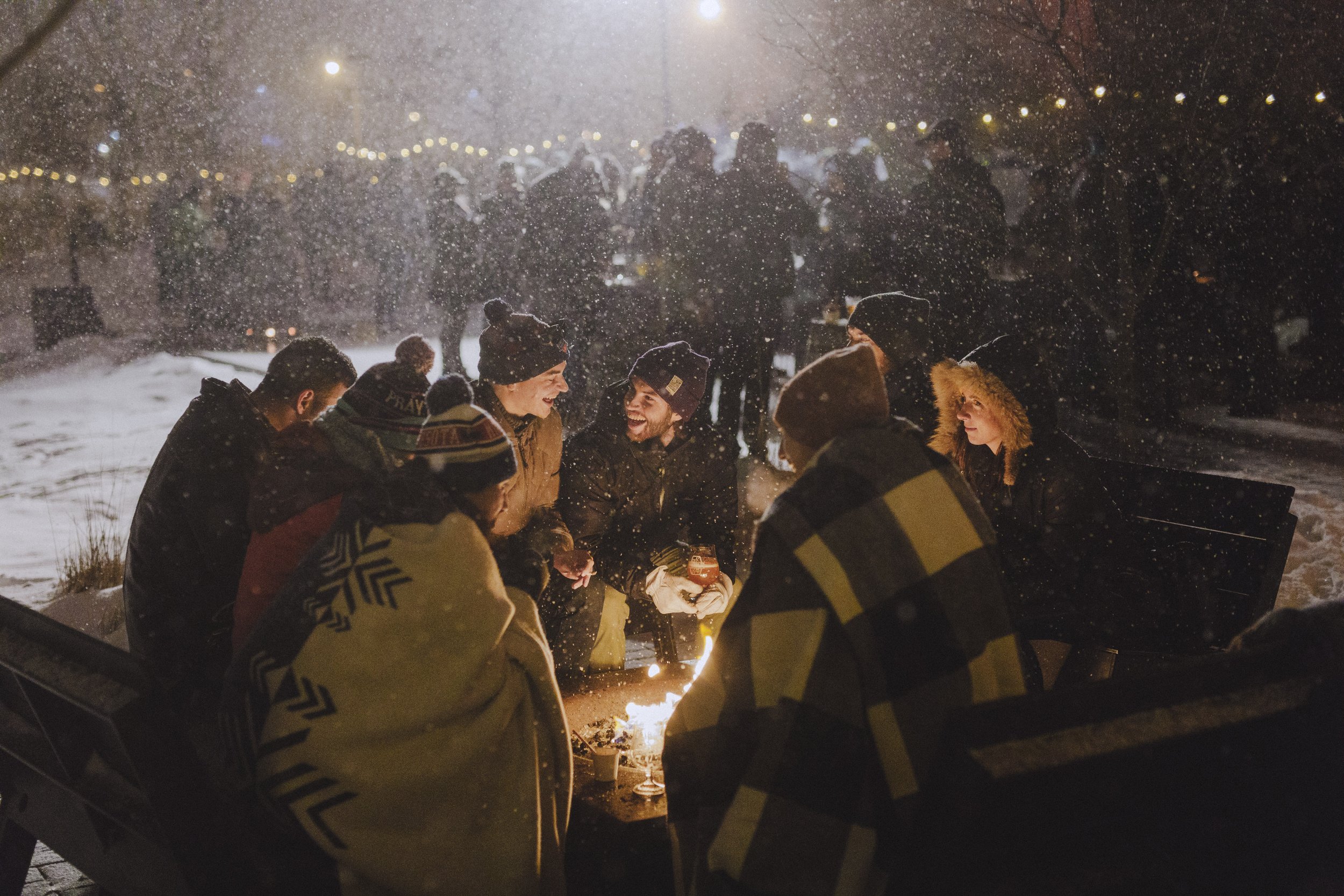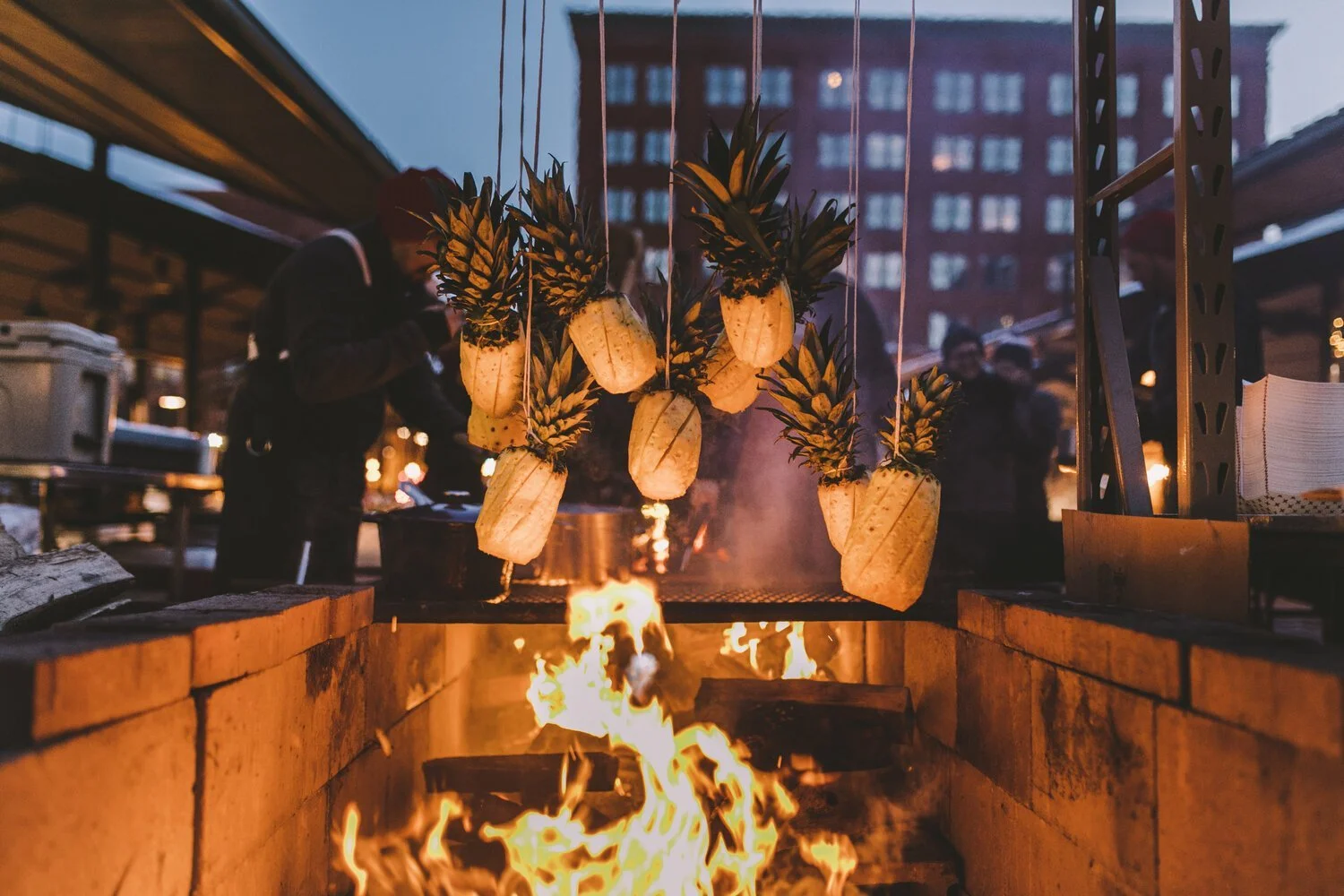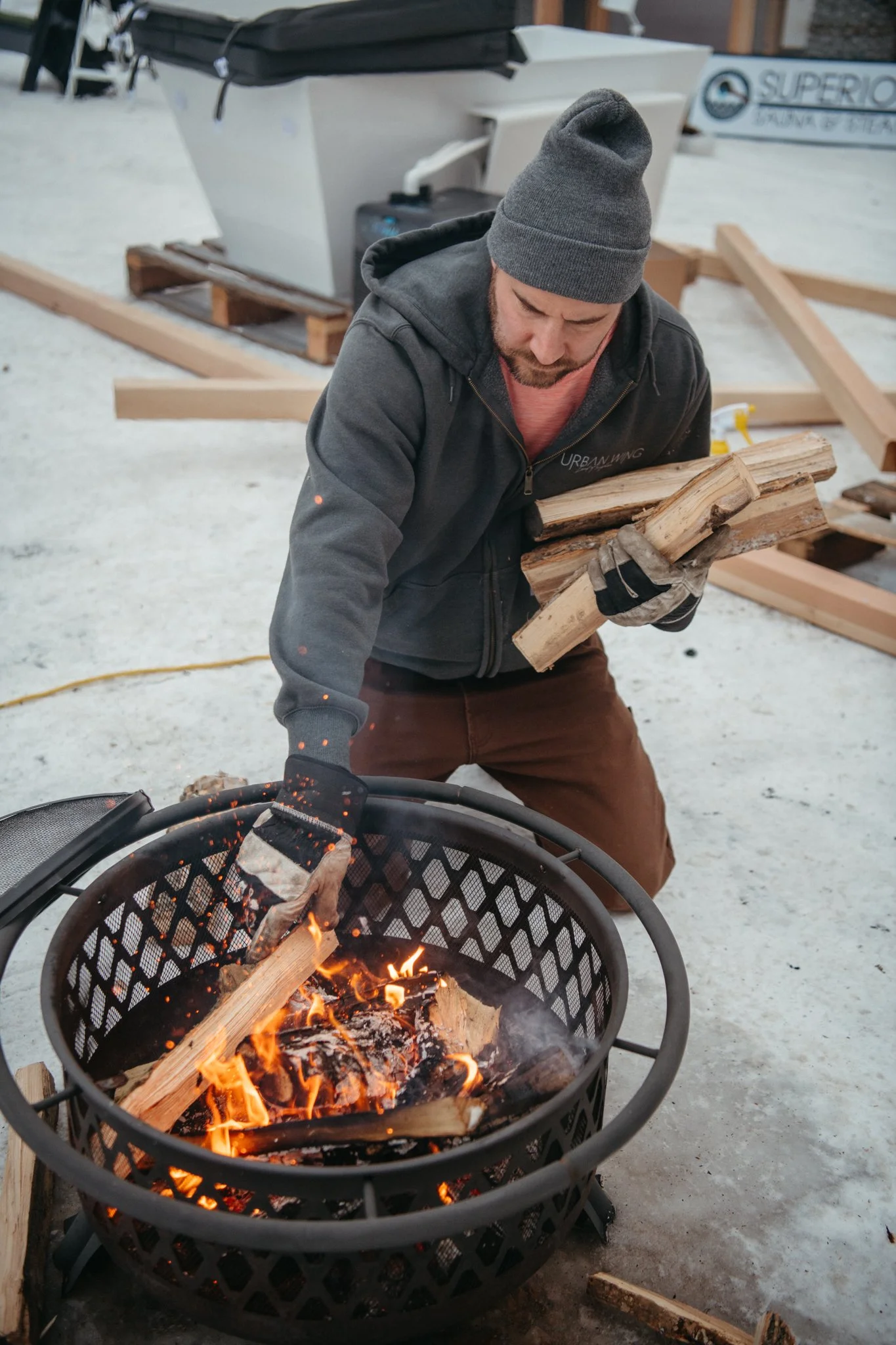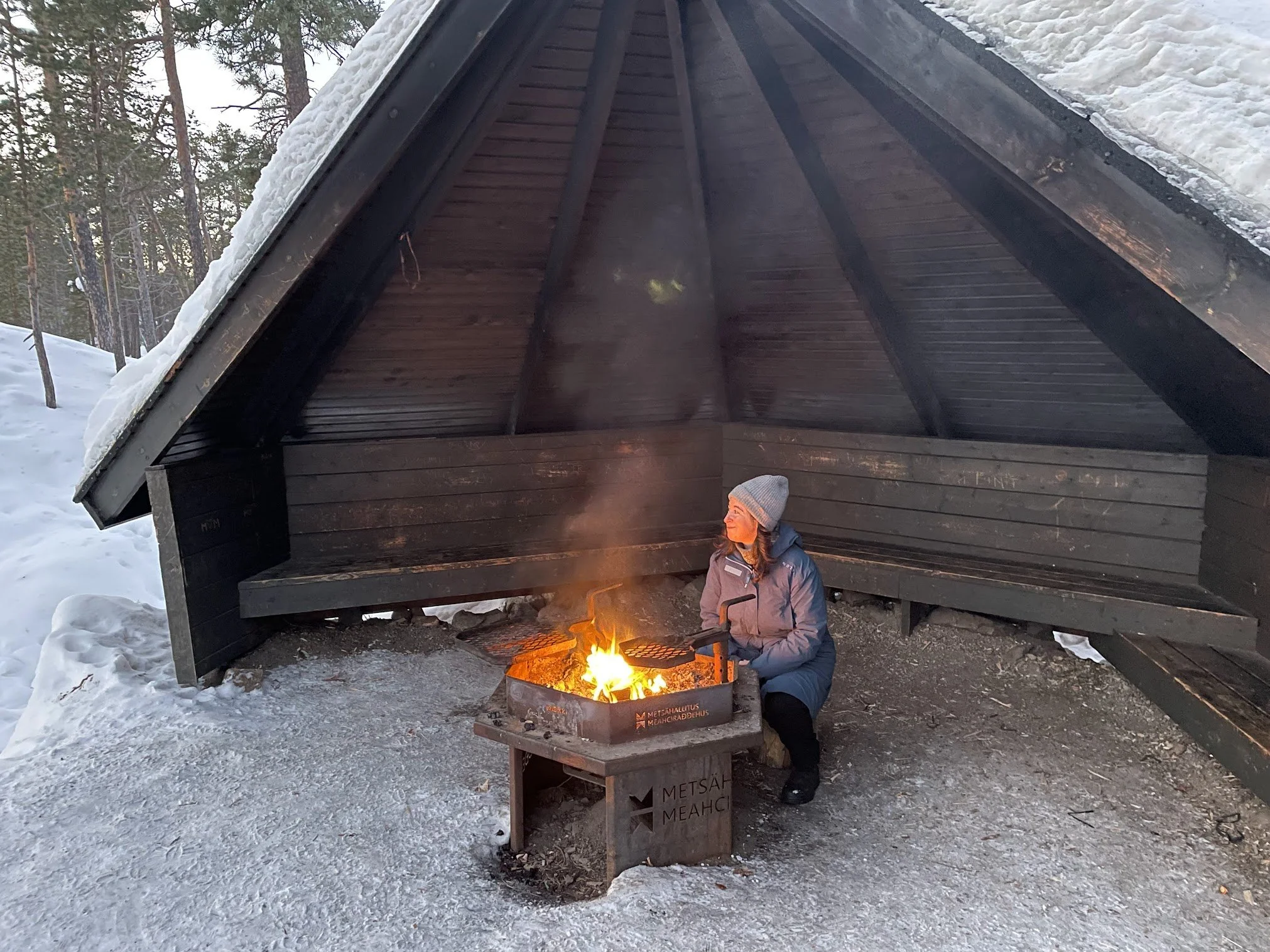How Fire Sparks Connection
To warm up for this year’s festival, we invited health psychologist, speaker, and writer Kari Leibowitz to reflect on the power of gathering around the fire on a winter night.
My husband, Rob, and I walked through snowy woods. We were in Finnish Lapland, about 165 miles north of the Arctic Circle. It was a mild January day, in the low 20s Fahrenheit, and the sun hung in the sky for a mere four hours. The weather was beautifully clear, and after a 2:37 pm sunset, we were treated to the northern sky painted pinkest pink, vivid orange, cherry red, and clear blue. We hiked a few kilometers on a wide, cleared trail through the forest, snow crunching under our feet.
When we arrived at our destination—the Jäniskoski suspension bridge, suspended over the rapids of Juutuajoki river, I was enthralled by what lay on the other side: at the apex of the five-kilometer hiking loop, set away from a small outhouse with a composting toilet, was a three-sided laavu. Laavut, similar to tipis, are traditional temporary homes used by the Sámi, the indigenous people of Scandinavia, who now reside primarily in northern Norway and Finnish Lapland. Laavut are slightly wider and squatter than tipis, making them more stable in high winds, and were designed to be easy to construct and deconstruct as Sámi reindeer herders moved across the land. The modern shelter I saw before me, which looked like a pointy-topped yurt with its front chopped off, housed a bench and a fire pit which, to my delight, had a fire burning, presumably lit by some previous hikers or perhaps some park employees.
We paused and warmed up by the fire, throwing on another dry log from the pile inside the laavu. I marveled at how it took so little to be so inviting: it was unspeakably comforting to come across a place of light and warmth in the middle of the forest, after we’d been hiking for an hour. We chatted with another couple—also visitors to the region—as they, too, had stopped to enjoy the fire.
In a part of the world that regularly sees temperatures in the single digits Fahrenheit, where the sun doesn’t rise at all for weeks during the winter, this fire sent a message: that this is a place for being outside, in nature, all year long. It provided a moment of warmth, rest, and connection in the midst of a day in the cold. It enabled us to recuperate, chasing the chill from our bones, and encouraged us to stop and linger. We made conversation with strangers, talking for far longer than we would have otherwise.
Fire invites this kind of connection. There is something about gathering around flames, indoors or out, that encourages intimacy. Strangers can become friends. Awkward pauses can become moments of comfortable silence. Staring into the flames, it becomes easier to bare our inner selves. Shrouded in darkness, lit only by the glow of firelight or candlelight, we can admit more to ourselves and others; vulnerability comes more easily and readily.
Research supports the magical, connecting power of fire. Jane Hurly, a researcher at the University of Alberta, in Edmonton, Canada, spent her PhD studying the experiences of leisure with recent Canadian immigrants. Her research brought her to the Long Lake Outdoor Centre in Alberta, where she spent the weekend with 70 refugees who came to the Centre to camp and participate in activities such as snowshoeing, skiing, and ice fishing for the first time. For these refugees, Canada’s winters were an unfamiliar and daunting part of acclimating to their new homes. Many arrived for the camping experience uncertain and hesitant. But, according to Hurly, people were drawn to the campfire. “It was a magnet for conversations to take place,” she said. One woman from the Democratic Republic of Congo talked about how, back home, the fire was the morning gathering place and the evening storytelling place. “Fire was a place of imparting wisdom,” Hurly told me, and having this replicated in an entirely different climate evoked feelings of nostalgia for immigrants in an unfamiliar landscape.
Tending the fire at Sauna Village, The Great Northern Festival 2023.
Other research suggests that the combination of darkness and fire is especially conducive to sharing your thoughts and feelings, storytelling, and connection. One study of the role of fireside gatherings among the Ju/'hoansi people of southern Africa found that while daytime talk around the fire focused on economic matters and gossip, nighttime fire talks were more communal and less confrontational: singing, dancing, and storytelling. Imaginative, community-strengthening conversations.
And while gathering around fire can happen in any climate, at any time of year, there is no doubt that winter’s cold gives us the opportunity to seek warmth and makes communing around fire particularly special. Fire transforms the cold and darkness of winter into an opportunity: for cozy evenings, where dinner is eaten by candlelight; for retreats reading and chatting around the fireplace; for outdoor excursions to grill hot dogs and roast marshmallows. Bonfires and candles allow the darkness to puddle and pool around us, creating sacred circles of warmth and intimacy. When fire pushes back the darkness and chill, it seems to push back our fear and anxiety as well. Lighting candles and sitting fireside can become mindful moments for connection: with ourselves, with each other, with the ancestors who came before us who have relied on flames since the dawn of humankind. Pausing around fire—to warm our fingers, to feel the heat on our faces, to contemplate the beauty of the flames—invites us to slow down. And all of this is possible not in spite of winter’s cold and darkness, but because of it. When the chill drives us to seek warmth in the flames, we end up finding so much more.
If you want to gather around fire this winter at The Great Northern, check out these events: at Silverwood Park, at the Walker, and at Sauna Village. And learn more about the power of fire during this conversation with Firekeeper Sandra Joy Agustin.
Kari Leibowitz is a health psychologist, speaker, and writer. She received her PhD in psychology from Stanford University, where she conducted research on harnessing mindset to improve health and wellbeing. Kari delivers talks and workshops on the power of mindset to international audiences, and her writing on this topic has appeared in The Atlantic & The New York Times. She is also the author of the forthcoming book, How To Winter: Harnessing Your Mindset to Embrace All Seasons of Life, which will be published by Penguin Random House in 2024. For more, visit karileibowitz.com.




